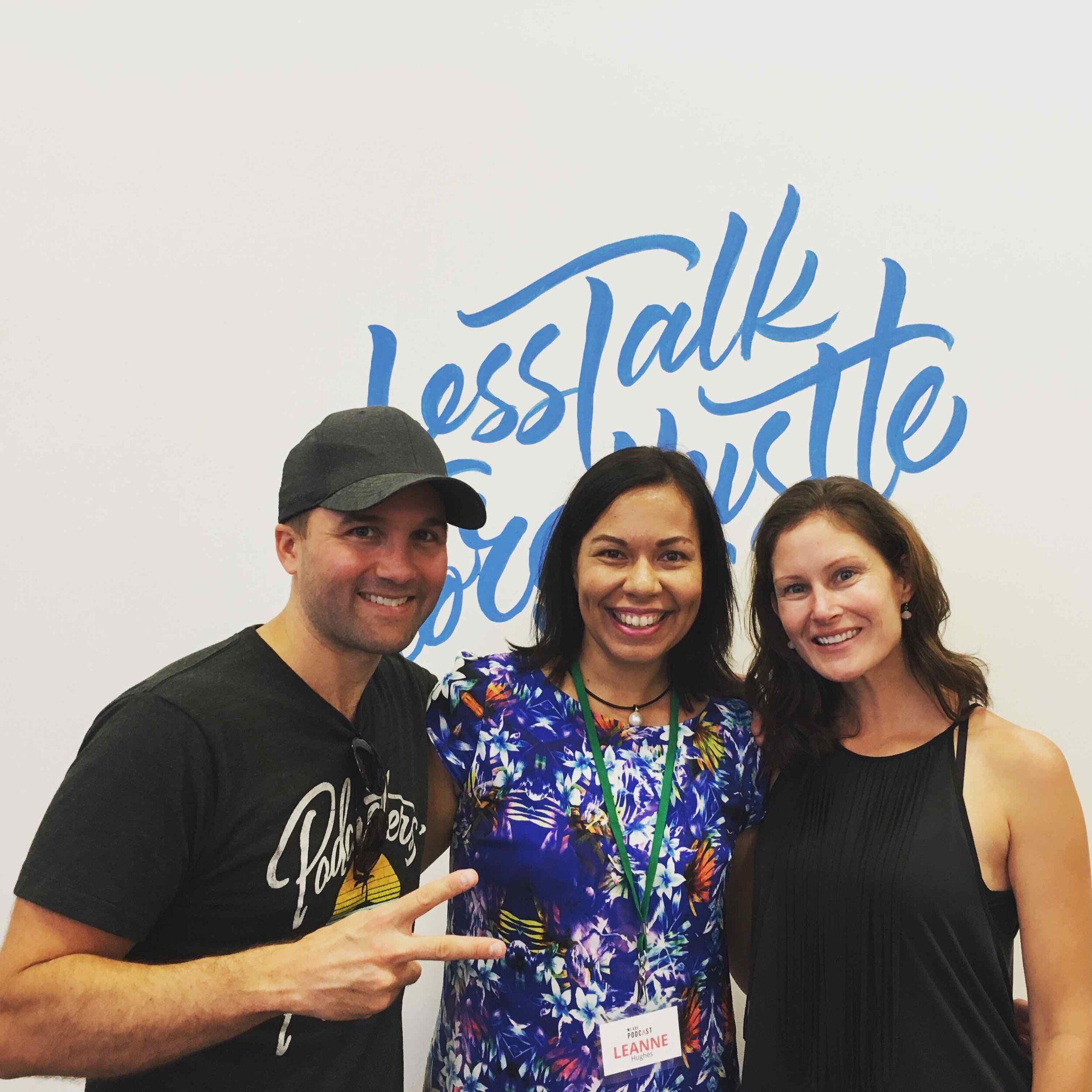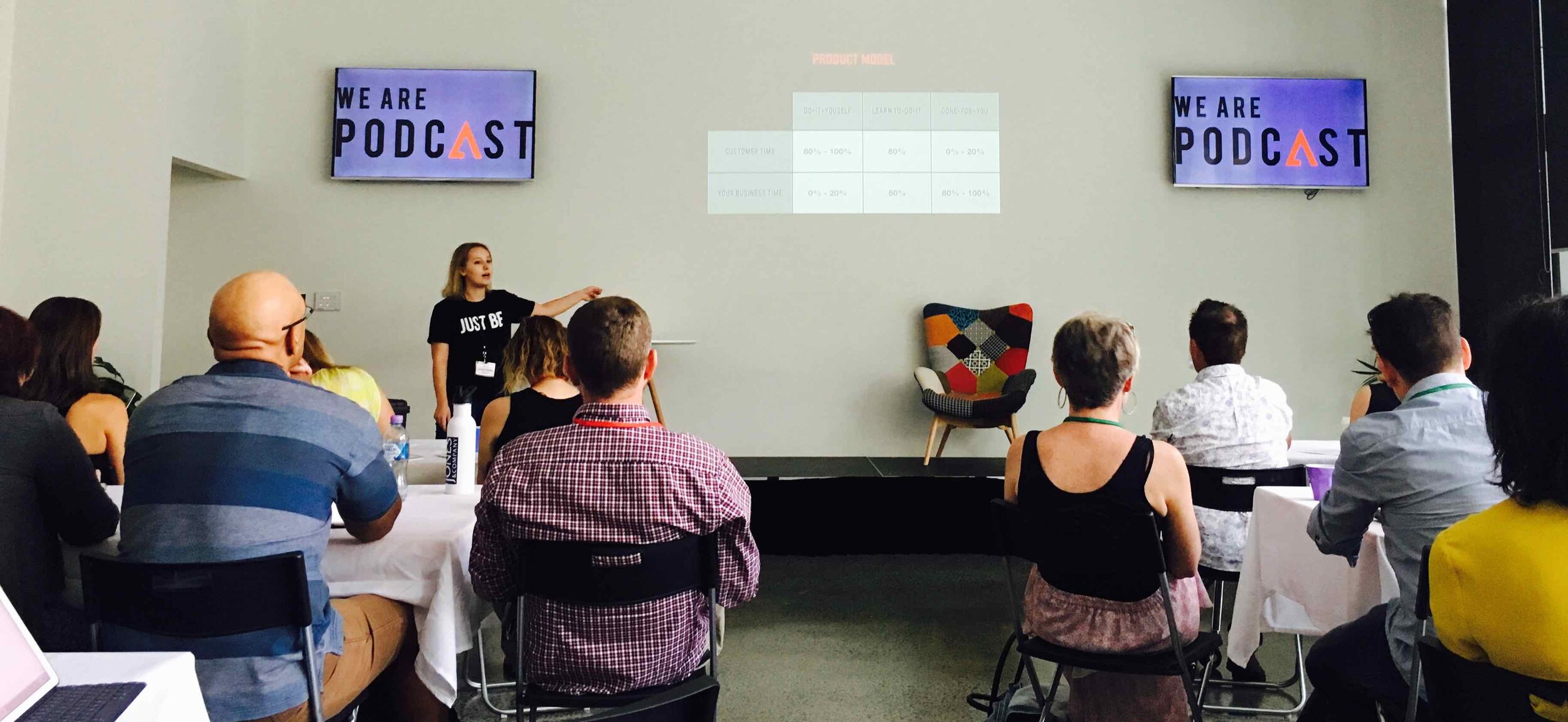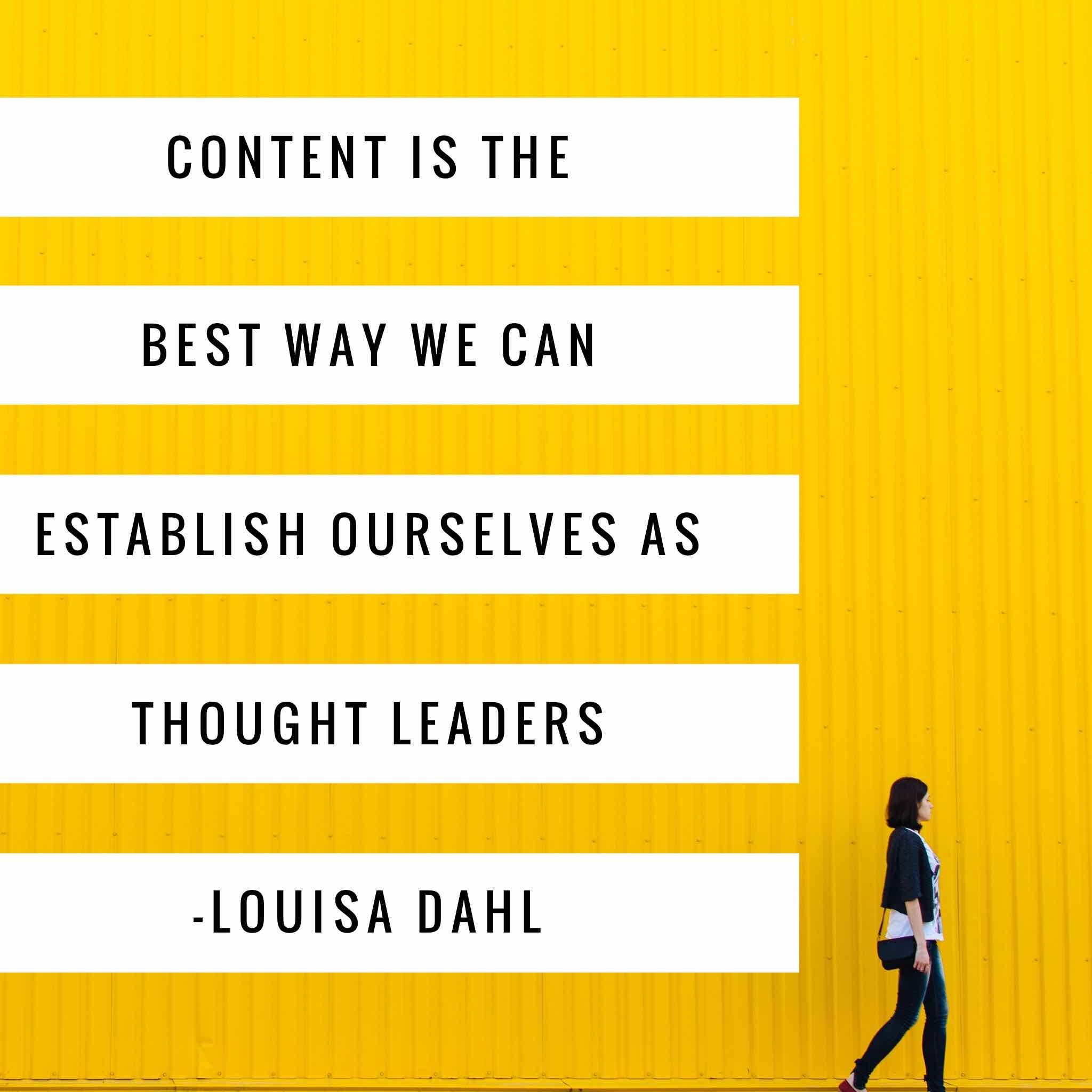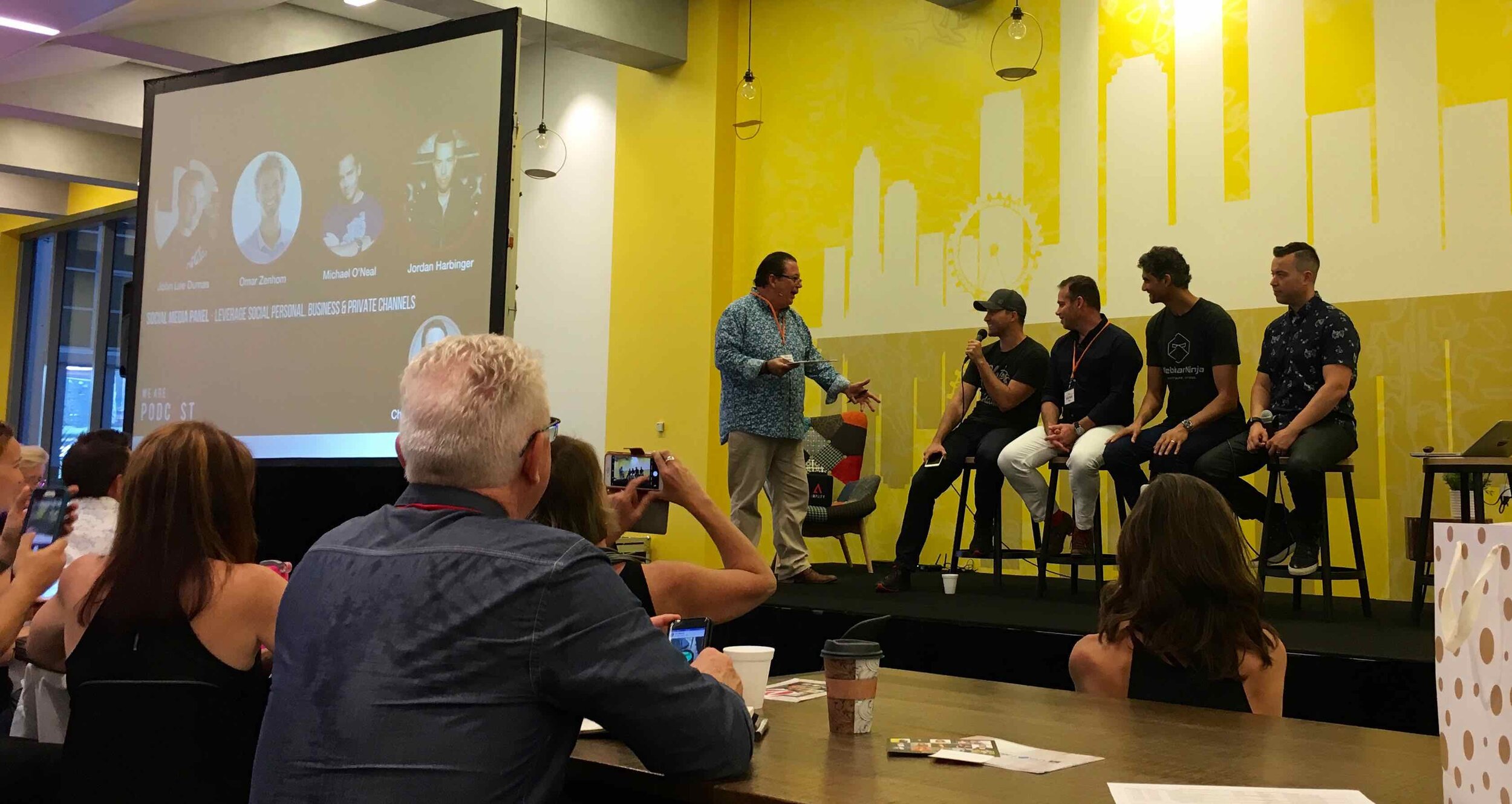35 Lessons I Learnt at the ‘We Are Podcast’ Conference
A few months ago I was cruising Eventbrite, having a look to see what events were coming to Brisbane and I saw an event titled We Are Podcast. Curious, I clicked the link and couldn’t believe the speaker list - podcast celebrities from the US who I frequently listen to on my daily commute; the likes of Jordan Harbinger from Art of Charm and John Lee Dumas from Entrepreneurs on Fire.I don’t have a podcast (yet) but I thought it would be an interesting way to learn about this medium. Without thinking about it too much, I paid my $690 registration fee, asked the boss for annual leave… and I was in.What a great decision. I’ve summarised the top three things I loved about the conference and also included a list of the top 35 lessons I learnt.Author's note, this is an informative post capturing my key notes from the conference, without too much reflection on what I'll do with them - more on that in future articles!
1. Putting the ‘Present’ into ‘Presenters’
 I’m used to attending conferences where the keynote speaker arrives five minutes before their spot, gives a pearler of a speech and then shoots off in a flurry.The biggest and best surprise about this conference is that the presenters hung around and they were accessible - you could walk up at any time for a chat. The chats weren’t one-sided either, they were genuinely interested and asked what you were up to and offered tips/advice. Thanks guys.
I’m used to attending conferences where the keynote speaker arrives five minutes before their spot, gives a pearler of a speech and then shoots off in a flurry.The biggest and best surprise about this conference is that the presenters hung around and they were accessible - you could walk up at any time for a chat. The chats weren’t one-sided either, they were genuinely interested and asked what you were up to and offered tips/advice. Thanks guys.
2. A Light and Bright Venue
I know there were some headaches with the audio, however, 5 stars to Fishburners as a conference venue. It’s centrally located, there are stacks of restaurants and pubs nearby, lots of natural light, cool break-out rooms and funky decor.I also liked that we weren’t thrown in like cattle and had to sit all facing the stage lecture-style. The conference room was setup cafe style, which allowed for easy conversation and note-taking.
3. Friendly, Community Vibe
Simon Sinek says ‘The leader sets the tone’ and I believe the architect behind ‘We Are Podcast’, Ronsley, reflected his brand and personality over the three days by creating a fantastic community vibe.The feeling in the room was casual and inspired; he hired a really great Master of Ceremonies, all of the staff members wore bold ‘Just Be’ black shirts and it was really easy to walk up to anyone and have a chat about their podcast, business, life.This was reinforced by the coolest roaming microphone I’ve ever seen - one that you can throw and catch to get questions from around the room. I had a look and you can buy it from GetCatchBox.
Here are the top two things I learnt from each speaker.
Day One: Workshop
A recap of the three workshops I attended on the first day.
Nicole Baldinu from the $100 MBA: Podcast Production Fundamentals
1. There are three key things you need to do when you decide to start a podcast. Nicole used the $100 MBA as her examples - I’ve included these below in italics.
- What’s the goal? Is it sales, engagement, to grow your community? (To teach real world business lessons)
- Determine the format of the podcast - interview format, quick tips, etc (Lesson-based, short format)
- Describe your show in one sentence (Daily, 10min lessons for the real world)
2. To create a point of difference, have a look at the other podcasts in the iTunes library for your category. Figure out how you can differentiate or add more value.
Stephanie Holland from Amplify: Amplify Your Product Launch
 3. Think about your product. If you offer a 1-to-1 product offering, how can you scale it? If you offer a 1-to-many product, how can you engage 1-to-1 high profile/high paying clients?4. Zero Moment of Truth (ZMOT) - People read ten pieces of content before they buy from you (Author’s note: I can 100% relate to this - I bought the Apple Watch Series 3 on Thursday and read about 10 articles before making that purchasing decision. I would also add that the number of articles you read is proportional to the cost of said product)
3. Think about your product. If you offer a 1-to-1 product offering, how can you scale it? If you offer a 1-to-many product, how can you engage 1-to-1 high profile/high paying clients?4. Zero Moment of Truth (ZMOT) - People read ten pieces of content before they buy from you (Author’s note: I can 100% relate to this - I bought the Apple Watch Series 3 on Thursday and read about 10 articles before making that purchasing decision. I would also add that the number of articles you read is proportional to the cost of said product)
Jason M from the Portrait Store: How to take the ultimate headshot selfie
5. Do the turtle - lengthen your neck when you take a selfie and keep your chin down.6. Connect with your audience. Instead of holding the camera up high, keep it at eye level. Don’t look into the glass… find that little hole at the front of your mobile, the camera lens and look all the way into it.
Day Two: We Are Podcast Conference
Andrew Griffiths: Master of Ceremony
7. He set the tone brilliantly - nice and relaxed, had a lot of information to cover but made it fun8. Reflected really well on what was being taught on stage, summarised it neatly, added his own stories and experiences to emphasise key speaker points.
John Lee Dumas from Entrepreneurs on Fire: Podcasting with a Purpose
9. Before you funnel down, you must funnel up - niching down is important. It’s lets you dominate that niche and get the momentum going. For example, as a social media marketer your target audience could be male dentists, based in the Brisbane area. Once you dominate this niche, you can look at broadening your audience to female dentists, dentists based in Sydney, etc.10. Have one avatar - this is the avatar that is going to serve you the most. JLD’s avatar is a guy named Jimmy, mid 30,s who spends 25mins driving to work in the morning, spends 9 hours in a cubicle for a job he doesn’t like (35mins on the way home cause of traffic) and all Jimmy wants to do is go fishing. When you need to make a decision in your business, think ‘WWJD’ - What Would Jimmy Do?
Sean DeSouza from Psychotactics : Pre-sell: How we Sellout Products/Courses in Mere Hours
11. He started a business because he wanted control - he defined control as a state of freedom from worry about income. Over the last 17 years, he and his wife have had 3 months worth of vacations every year. He calls it - ‘downtime by design’. (Author’s note: Hear, hear!)12. He spoke about the importance of the pre-sell (‘People buy before they pay) and used the metaphor of an upcoming wedding to use as the format for your pre-sales (i.e. give away high level details and stagger these announcements over time).13. His secret weapon is sending physical product to his clients - it’s incredible what a personalised cartoon postcard and a box of chocolates can do!
Glen Carlson from Key Person of Influence: Assets of Influence
14. He highlighted proximity bias and that we tend to devalue the things that are close to us (I think this links into imposter syndrome). He likened this to our relationships, our thoughts and ideas.15. He said that any stress, frustration or bottle neck can be traced back to an asset deficiency. Give your teams/people more or better assets - don’t throw more money or time at your team’s problems, ask yourself the question: ‘What’s the missing asset?’.
Louisa Dahl from Interactive Minds: How to position yourself as an in-demand expert
 16. Think about your results and ask yourself how to make it real. For example, ‘How many widgets do I need to sell to make my own salary?’17. Content is the best way to establish ourselves as thought leaders.
16. Think about your results and ask yourself how to make it real. For example, ‘How many widgets do I need to sell to make my own salary?’17. Content is the best way to establish ourselves as thought leaders.
Clarissa Rayward from the Happy Family Lawyer: From Lawyer to Podcaster - Turning a traditional business on its head through podcasting
18. Build fast, fail fast - do the do. If you have to think of an idea, try ‘speed-thinking’ and giving yourself a tight deadline to make it happen. She provided a great example: If you need to go to work at 8.30am and you wake up at 8.20am… you still find a way of getting ready in time. Use the same thinking to get things done.19. Mindfully pay attention to the feedback that you’re receiving…there may be something in it.I had to leave the conference after this event at this stage to be the Master of Ceremonies at an awards night, so I missed the last few presentations from Danielle Lewis, Nathan Chan and Kate Erickson. But I had a great night’s sleep and was full of energy when I arrived for the final day.
Day Three: We Are Podcast Conference
Ronsley Vaz from Amplify: Product Ecosystems - Content assets and customer journeys
20. The question isn’t how to grow… it’s how to grow efficiently. This involves an overlap of Convincing, Converting and Automating your customers/systems and processes.21. Treat your customers like an intimate relationship - you don’t ask someone to marry you when they first meet you, so stop aggressively sell them stuff! Work your way through four stages:
- Attention (Solve a headache)
- Engagement (Remove obstacles)
- Sales (Address an aspiration)
- Client (Pursue a desire)
Amber Hawken - The Skill of Selling from your Soul
After busting out the macarena, we learnt to:22. Remember that when you are doing anything (particularly podcasting) - it’s not about you. It’s always about your audience.23. Our heads feel fear and rejection. When you’re working on your business, try to get out of your head and just be/do/create.
Omar Zenhom from Webinar Ninja
24. We need to incorporate Webinars into our marketing efforts for three reasons.To:
- Collect emails
- Create trust as it’s a two-way conversation
- Grab attention - You can do similar things on Facebook Live, but Facebook is full of distractions; where as webinars are a controlled environment.
25. You create your webinars for three different types of audiences:
- Never heard of podcasting
- Never heard of your podcast
- Have listened to a podcast but haven’t subscribed.
Yann Ilunga from 360 Entrepreneur: Podcast to Virtual Summit
26. He outlined how to use your summit to build your audience and to approach promotion of your virtual summit like a music festival.27. He brought up a great point about making it easier for your summit guests to promote their interview by sending them Canva images and spiel.
Emma and Carla from The Merry Maker Sisters: Five things we’ve done to create an awesome, loyal community
28. Treat your community at the same level as you. Value your brand champions.29. They’re successful as they have fun. They evaluate an idea and if it doesn’t make them excited, the idea is benched.
James Tuckerman from Not So Freaky University: The 12 Principles of Persuasion and Influence
I won’t outline all of the twelve steps but my favourite ones were:30. Clarity booster - you can describe this in three different ways:
- Outcomes
- Things (most people say this
- Feelings
For example, you say you’re in the business of ____ (things). But, all your customers really want is a ‘fist-pumping moment’ (a feeling). It’s important to identify all three.31. De-risk it - Highlight the potential Return on Investment - but talk more in terms of the potential cost of inaction. This is what drives 80% of action. For example, would you be more motivated to run towards a cuddly bear; or run away from a grizzly bear?
Michael O’Neil from the Solopreneur Hour: The Art of the Interview
32. When you introduce your guests, the last two words should be their name (example, ‘…She’s based in Brisbane and I’d like to welcome award-winning author, Jane Smith).33. You want your guests to talk in stories. His all-time favourite question to ask guests is ‘What does your child-hood smell like?’ as this evokes feelings and stories that you can often relate to through the interview.
Jordan Harbinger from the Art of Charm: How I learnt to network from getting kidnapped
34. Put 1-2% of your salary into a ‘holding fund’ so if an amazing conference comes up which involves travel/cost - you can attend through proper planning.35. The best value is not in your bank account - the best value is your network. List the top 10 people you would contact if you lost your job tomorrow. How are you keeping in touch with them and offering them value? Always give value.
On another note...
Funny story. MC Andrew announced that there would be a lucky draw prize on the third day. All you needed to do was write down your name, your podcast title, what it was about and pop this in the draw. I don't have a podcast but I entered anyway. My philosophy was 'If I get selected, then it's a sign that I need to start it'. At the end of the day, my idea was plucked out of the draw! Crazy. Guess I better get to work so I can report back to Ronsley and the team at We Are Podcast 2018...Do you agree with these podcasting and business tips or have any more to add? Comment below![contact-form][contact-field label="Name" type="name" required="true" /][contact-field label="Email" type="email" required="true" /][contact-field label="Website" type="url" /][contact-field label="Message" type="textarea" /][/contact-form]
